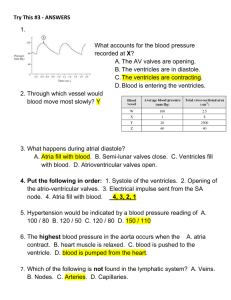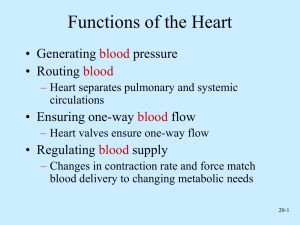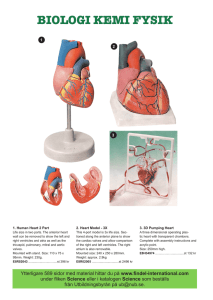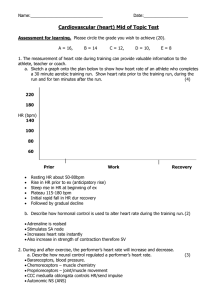Model Answers
advertisement
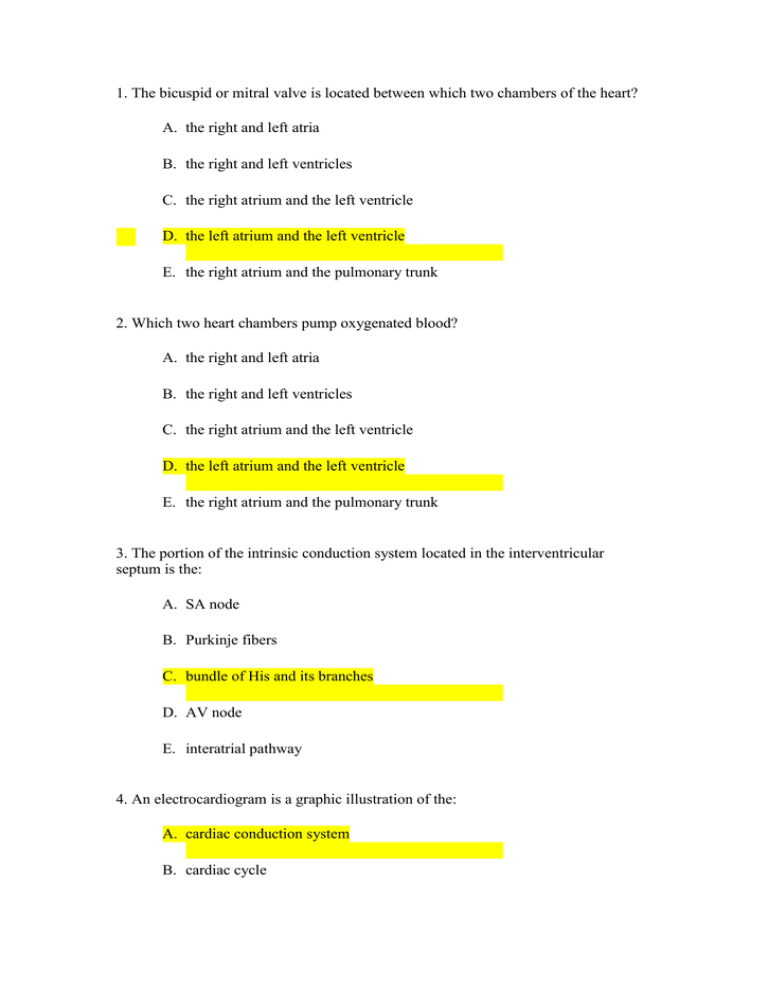
1. The bicuspid or mitral valve is located between which two chambers of the heart? A. the right and left atria B. the right and left ventricles C. the right atrium and the left ventricle D. the left atrium and the left ventricle E. the right atrium and the pulmonary trunk 2. Which two heart chambers pump oxygenated blood? A. the right and left atria B. the right and left ventricles C. the right atrium and the left ventricle D. the left atrium and the left ventricle E. the right atrium and the pulmonary trunk 3. The portion of the intrinsic conduction system located in the interventricular septum is the: A. SA node B. Purkinje fibers C. bundle of His and its branches D. AV node E. interatrial pathway 4. An electrocardiogram is a graphic illustration of the: A. cardiac conduction system B. cardiac cycle C. cardiac output D. systemic and pulmonary circuits E. coronary vessels 5. Which two great vessels bring deoxygenated blood back to the heart? A. the aorta and the pulmonary trunk B. the pulmonary arteries and the pulmonary veins C. the superior and inferior venae cavae D. the aorta and the superior vena cava E. the coronary arteries and the coronary veins 6. An average heartbeat, or cardiac cycle, lasts approximately: A. 8.0 seconds B. 80 seconds C. 0.80 seconds D. 0.008 seconds E. 60 seconds 7. During Phase 2 of the cardiac cycle, which of the following events are occurring? A. Atria relax (diastole) while the ventricles contract (systole); AV valves are closed while the semilunar valves are open. B. Atria contract (systole) while the ventricles relax (diastole); AV valves are open while the semilunar valves are closed. C. Atria and ventricles are relaxed (diastole); AV valves are open while the semilunar valves are closed. D. Blood moves from the right ventricle into the pulmonary trunk, while blood moves from the left ventricle into the aorta. E. both a and d are correct 8. The P wave of the ECG represents: A. ventricular depolarization B. atrial depolarization C. ventricular repolarization D. SA node excitation E. atrial systole 9. During Phase 1 of the cardiac cycle, which of the following events are occurring? A. Atria relax (diastole) while the ventricles contract (systole); AV valves are closed while the semilunar valves are open. B. Atria contract (systole) while the ventricles relax (diastole); AV valves are open while the semilunar valves are closed. C. Atria and ventricles are relaxed (diastole); AV valves are open while the semilunar valves are closed. D. Blood enters the right atrium through the venae cavae and the left atrium through the pulmonary veins. E. Both b and d are correct. 10. During Phase 3 of the cardiac cycle, which of the following events are occurring? A. Atria relax (diastole) while the ventricles contract (systole); AV valves are closed while the semilunar valves are open. B. Atria contract (systole) while the ventricles relax (diastole); AV valves are open while the semilunar valves are closed. C. Atria and ventricles are relaxed (diastole); AV valves are open while the semilunar valves are closed. D. Blood enters the right atrium through the venae cavae and the left atrium through the pulmonary veins. E. Both c and d are correct. 11. Once action potentials are generated by the heart's intrinsic conduction system, they are conducted from myocardial cell to myocardial cell via ___________________ located in the _____________. A. desmosomes; intercalated discs B. gap junctions; intercalated discs C. actin and myosin; sarcomeres D. myofibrils; desmosomes E. T-tubules; sarcolemma Model Answers: 1. 2. 3. 4. 5. 6. 7. 8. 9. 10. 11. D D C A C C E B B E B

